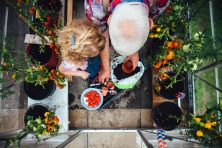Plant a Cost-Effective Garden: These Veggies are Cheaper to Grow Than Buy

Thinking of starting a garden to save money on your grocery budget? There’s good news and bad news.
Let’s get the bad news out of the way first: Not everything you plant will be a money-saver. Tending to a garden takes time and effort, and for some veggies, the return on investment doesn’t pay off.
Now, on to the good news: We’ve got the scoop on which veggies are worth the effort, thanks to Bottom Line Publications, with some backup from How Stuff Works.
So, which veggies can you grow to save money eating from your garden, and which are so cheap at the grocery store that it’s not worth the garden space? Let’s take a look.
Most Cost-Effective Veggies to Grow
These are the veggies you’ll want to plant — they’ll give you the most bang for your buck compared to what they cost at the store.
Salad Greens
Planting arugula, Swiss chard and spinach can net you ridiculous savings at the grocery store. Just how ridiculous?
Consider these numbers: A bag of prewashed grocery store lettuce that gives you maybe enough for two salads can cost up to $5. (Not to mention how hard it is to find a totally wilt-free bag.)
Or, for $2 to $3, you can buy a seed packet that will keep you supplied with fresh salad greens every day for roughly five months. They’re easy to grow, easy to tend and easy to harvest.
Your savings could be in the hundreds of dollars. (And, let’s be honest, fresh salad just tastes much better.)
Cherry Tomatoes
You can pay up to $5 a pint for heirloom cherry tomatoes at a grocery store or farmers market, or you can grow around 20 pints of your own for the cost of a $2 to $3 seed packet. Which seems like the better deal to you?
Note: Heirloom cherry tomatoes are better than larger varieties due to a longer growing season and higher crop yield. They need six or more hours a day of full sun, though, so consider your garden arrangement before planting them.
Green Beans
Specifically, I mean string greens or snap beans. With full sunlight, they grow very well, and each plant can yield several pounds of beans (which go for $6 to $7 a pound at farmers markets).
Herbs
These include parsley, basil, rosemary and thyme. They’re easy to grow even in your kitchen: Set up a few small pots on a windowsill that gets four to six hours of light a day.
These herbs can be pricey if you buy them fresh — $2 to $3 for just a few sprigs vs. $2 to $3 for a full pack of starter herb plants that can net you up to 50 times that measly supermarket purchase.
If you use herbs at all in your cooking, you owe it to yourself to grow your own. Some herbs, like rosemary, can live from year to year, so you can enjoy fresh herbs even in the winter!
Honorable Mentions
They’re not listed in the article but get high marks from readers for both ease of care and overall yield: summer squash, carrots, zucchini and leeks.
Least Cost-Effective Veggies to Grow
They might be delicious, but they’re not the best options for your garden, especially if you’re working with a small space.
Tricky to Grow or Susceptible to Pests and Disease
The following plants need very specific care and often yield smaller crops (and smaller savings) than they’re worth:
- Artichokes
- Carrots
- Cauliflower
- Celery
- Eggplant
- Head lettuce (not to be confused with the leafy salad greens above)
Just Plain Cheaper in Stores
Onions and potatoes are so inexpensive to buy that growing your own won’t make much difference to your overall grocery costs. Plus, potatoes require a lot of water, so if you live in a dry climate, you might seriously increase your water bill.
How to Maximize Your Garden
A few tricks can help you make the most of your garden space, even if it’s small, to save money on food over the spring, summer and beyond.
Only Plant What You’ll Eat
This sounds like common sense, but more than one backyard gardener has been tempted to plant a variety of impressive-sounding foods they never actually use.
Only like tomatoes on certain things? No one in your house but you eats squash? Then you’d be silly to plant and nurture them. If you rarely eat something, just buy it whenever you do eat it.
Don’t Plant All at Once
When it comes to salad greens, you want to plant a small number of seeds each week rather than planting them all at once. This allows you to harvest the outer leaves as you need them while the rest of the plant keeps growing, keeping your supply going all growing season.
Freeze Your Extras
More zucchini than you know what to do with? Freeze it to use in recipes throughout the winter, like casseroles or zucchini bread. Same goes for most veggies — unless it’s something like lettuce, store away your extras so they won’t go to waste.
Kelly Gurnett is a freelance blogger, writer and editor who runs the blog Cordelia Calls It Quits, where she documents her attempts to rid her life of the things that don’t matter and focus more on the things that do. Follow her on Twitter @CordeliaCallsIt.


















